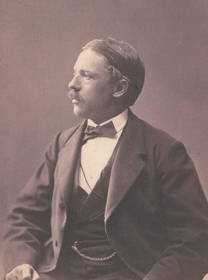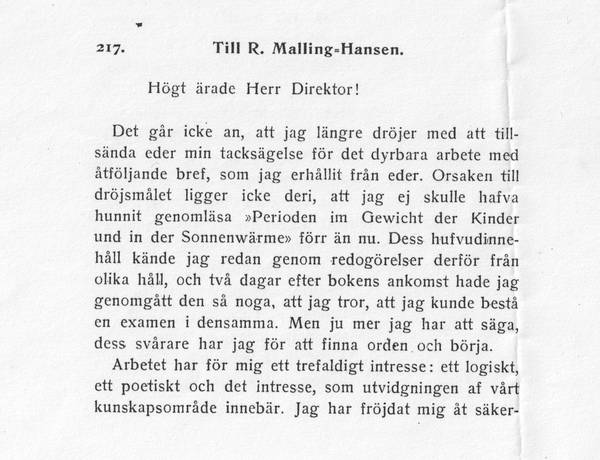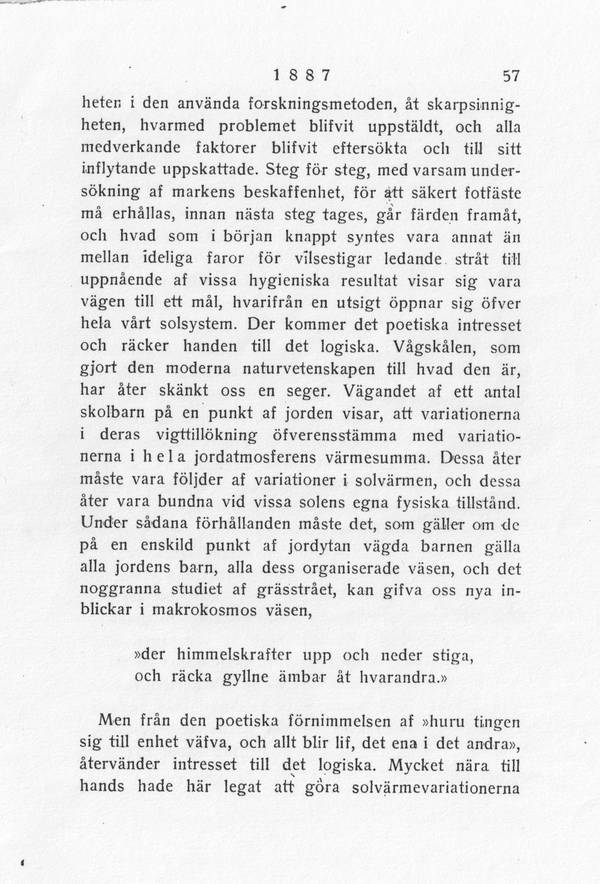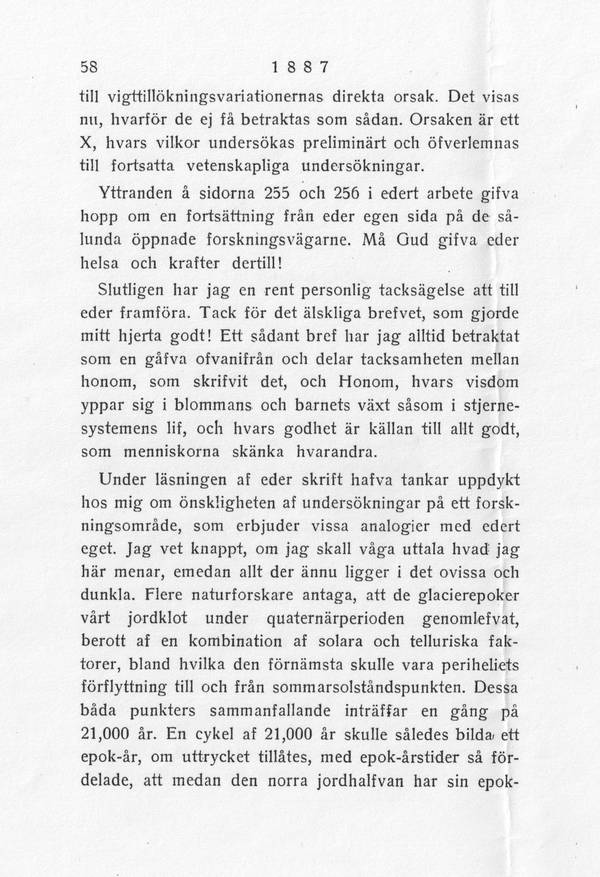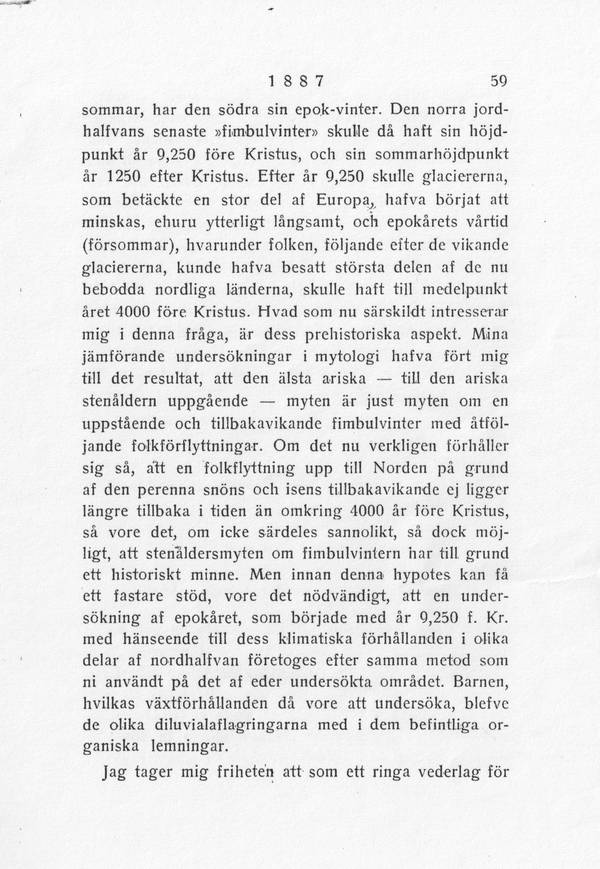1887.11.12 English
1887.11.12 English
This letter to RMH is included in ”Letters from Viktor Rydberg. Selected and Published by Emil Havermann, III”, Stockholm; Albert Bonnier Publ. Company, 1926, pp 56 (in Swedish).
Mr Tore Lund of the Viktor Rydberg Society ( http://vrsidor.se ) who kindly notified us about the letter and its location, wrote as follows about its content (letter to JMC dated 22 Nov 2009):
“During the latter part of his life Rydberg was very famous and received numerous books and manuscripts in the most diverse subject areas. It was problematic for him to reply to all of these gifts, because he was a bad correspondent and always felt that he was short of time. The replies are all polite but mostly short. The letter to Malling-Hansen is unusually long and it is no exaggeration to also add that it is uncharacteristically warm. I feel that Rydberg to quite an unusual extent is showing his “religious” or “godly” side (“....Such a letter I have always regarded as a gift from above” etc) – perhaps in an attempt to oblige the addressee.”
My Dear Sir,
It won’t do delaying any longer my acknowledgment with thanks and appreciation for the precious work and accompanying letter from you. The reason for the delay is by no means that I shouldn’t have taken the time to read “Perioden im Gewicht der Kinder und in der Sonnenvärme” until now. The gist of its content I knew beforehand through reports from various quarters[1], and not yet two days after the arrival of the book I had perused it so thoroughly that I believe I could have passed an examination in it. However, the more I have to comment, the more difficult it is for me to find the words and get started. To my mind the work has triple interest: logic; poetry; and the interest linked to the enlargement of our domains of knowledge. I have been delighted by the proficiency of the research method applied as well as by the perspicacity of the formulation of the problem, and to how all contributory factors have been researched and estimated in relation to their influence. Step by step, carefully probing the character of the ground in order to secure a safe foothold before the next step the expedition proceeds, and that which in the beginning seemed but frequent dangers to be led astray along paths for achieving some certain hygienic results, reveal themselves to be the road to a goal from where a view opens up to our entire solar system. This is where the poetic angle appears, holding out a hand to the angle of logic. The scale which has brought about the present state of modern science has once again granted us a victory. The weighing of a number of school children at one point of the planet shows that the variations of their weight increases correspond to the variations of the sum of heat in the e n t i r e earth atmosphere. These, in their turn, must be caused by variations of the solar heat, and these must again be a consequence of certain physical conditions of the sun. Under such circumstances what is valid for children weighed in one particular place on the surface of the earth must be in force for all children of the earth; all living creatures, even the thorough research into a leaf of grass, may provide us with new insights into the nature of macrocosm,
“where heavenly forces ascend and descend, passing golden pails to each other.”
But from the poetic feeling of “how things weave themselves into a unity, and everything becomes life, one into the other”, our interest turns back to logic. It would lay near at hand to make the fluctuations of solar heat the direct cause of the variations in terms of weight increases. However, it is then shown why they must not be regarded in that way. The causal reason is an X, the conditions of which receive preliminary research and are left for continued scientific investigations[2].
The statements on pages 255 and 256 in your work offer hope about a continuation from your side of the research routes thus opened by yourself. May the good Lord grant you good health and the strength to travel them![3]
To round off I have a personal message of thanks to convey to you, Sir. Thank you indeed for the warmhearted letter that pleased my heart so much! A letter like that I have always regarded as a gift from above and I share the sense of gratitude between the person that wrote it and He whose wisdom is seen in the growth of the flower and the child as well as in the life of stellar systems, and whose grace is the source of all goodness that human beings bestow on each other.[4]
While reading your publication some ideas have come forth about the need for investigations in an area of research that offers certain analogies with your own, Sir. I hardly know if I dare express clearly what I am referring to, since everything in that field is still uncertain and obscure. Several scientists assume that the glacial epochs that our planet went through during the quaternary periods depended on a combination of solar and tellurian factors, among which the foremost one would be the movement of the perihelia[5] to and from the point of summer solstice. The coincidence of these two points happens once every 21 000 years. Hence, a cycle of 21 000 years would then constitute an ‘era’ if you permit me the expression, with era-years distributed such that while the northern hemisphere has its era-summer, the southern hemisphere has its era-winter. The last harsh winter – ‘Fimbul-winter’ - of the northern hemisphere would then have had its zenith in the year 9,250 years BC and would experience its summer zenith in the year 11,250 AC. After the year 9,250 BC the glaciers covering a large portion of Europe started to shrink, albeit exceedingly slowly, and the springtime of the era-year during which the humans, following the receding glaciers would have been able to occupy the major part of what presently constitutes the inhabited northern countries, would have as its medium point in time the year 4,000 BC. That which particularly interests me in this issue is the pre-historical aspect. My comparative studies in mythology have led me to the conclusion that the most ancient Aryan[6] myth – stemming from the Aryan stone age – is precisely the myth about an emerging and receding Fimbul-winter, accompanied by movements of the population. If the reality is that a population movement towards the Nordic area in consequence of the receding of the eternal snow and ice took place no further back in time than around 4 000 years BC, then it would be possible – albeit not very likely – that the stone age myth about the Fimbul-winter is founded on a historical memory. However, for this hypothesis to become more firmly supported it would be necessary to undertake an investigation of the era-year starting in the year 9 250 BC in relation to its climatic conditions in different part of the northern hemisphere, applying the same method used by you, Sir, in the geographic areas investigated.[7] Just that instead of researching the growth conditions of children, the various diluvial deposits with their organic remains would be the focus of investigations. I am taking the liberty to send you my “Investigations in German Mythology” [8]as a modest return for your gift.
Yours very sincerely, Viktor Rydberg.
Stockholm November 12, 1887
[1] SA: In other words, Viktor Rydberg already knew about RMH’s research before he received RMH’s letter in 1887. This is no wonder, since RMH’s research was attracting attention all around Europe and possibly made him more famous among scientists abroad than in Denmark. My impression is that RMH himself was very disappointed by the apparent indifferent response with which he was met from many quarters in his own country.
[2] SA: In 1887 RMH was of the opinion that he hadn’t yet found out the whole truth about the causal factors behind the cyclical growth of children, but he himself assumed that he was on the track of an unknown growth factor that he called “X” and felt that he would be able to show that X was closely connected to the solar heat variations. RMH was, as we know, a very religious person, and my impression is that he meant that our terrestrial world was governed by cosmic regularities of divine origin. That all growth on earth was possibly controlled by the rays of the Sun was a notion that I believe caught on in his mind. However, posterity has probably shown that the cosmic regularities RMH was looking for do not exist, unfortunately. In our time obviously we know much more about how the sun rays influence the growth of various organisms on earth, but it does appear clear that the variations in terms of increased weight and height are due to other factors than the rays of the Sun. RMH carried on his very expansive research, including weighing stations around the world, up until his sudden death in 1890. We don’t know very much about the outcome of these investigations for in 1911 the results, as well as a draft new manuscript, were destroyed by some of RMH’s daughters. They saw themselves as spiritual researchers and thought that they were in contact with RMH’s spirit and that it was he who wished the last pieces of work destroyed on the ground that they were not sufficiently well founded.
[3] SA: In truth RMH really needed all possible good wishes for his health, for his state of health was miserable , and he died from heart failure in 1890.
[4] SA: Words such as these, expressed so poetically and charged with religious emotions, were probably like balm for RMH’s mind and surely strengthened him yet further in his belief that he was on track of something really grand!
[5] JMC: Perihelia = The point in the orbit of a planet or comet at which it is nearest to the sun
[6] JMC: When Rydberg refers to the concept of ’Aryan’ the connotation is probably about the original speakers of Indo-European languages and their descendants. In 20th century colloquial language and in the context of Nazi German philosophy, the term took on a racial propaganda slur, denoting a certain superior Nordic race.
[7] SA: I don’t know if Viktor Rydberg ever developed these ideas further, but it would be fair to say today that the connection he is imagining to glimpse as contours, is not there.
[8] SA: Comments to the letter 1887.10.18 presents a short biography of Victor Rydberg as well as an overview of his research and literary works

